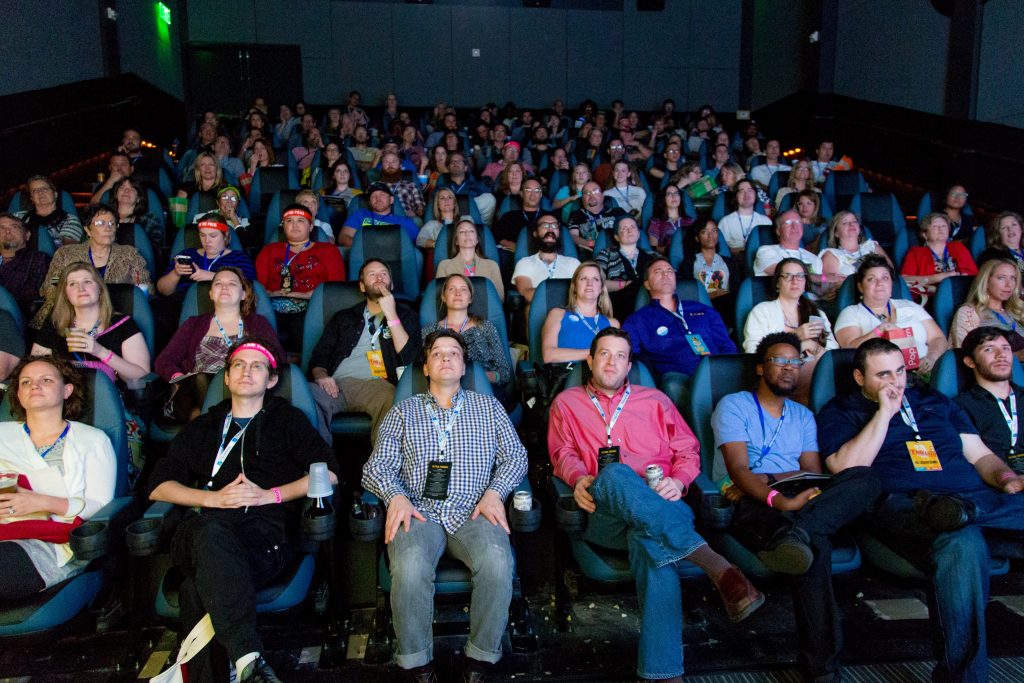Let me begin by saying that the following is just one woman’s opinion. (Just, like, my opinion, man.) For all of my fire, I am at heart a take-it-or-leave-it kind of person when it comes to my musings. That said, I have a lot of experience with visual art, so I felt compelled to express my thoughts on the 2015 Louisiana Film Prize.
 I am a firm believer that everyone is born creative, and I also believe that visual art (and music, dance, etc.) has a certain set of tenets and measures for quality. In other words, though we are all born with the potential for creative expression, some people choose to ignore it, others find a forum for that expression outside of the art world (designers, blacksmiths, healers, teachers, gardeners, farmers…), and others commit themselves directly to art-making, which involves not only that innate potential, but also a dedication to study of the craft. The latter would be very difficult without practice and criticism. No one ever became a better artist or thinker without it.
I am a firm believer that everyone is born creative, and I also believe that visual art (and music, dance, etc.) has a certain set of tenets and measures for quality. In other words, though we are all born with the potential for creative expression, some people choose to ignore it, others find a forum for that expression outside of the art world (designers, blacksmiths, healers, teachers, gardeners, farmers…), and others commit themselves directly to art-making, which involves not only that innate potential, but also a dedication to study of the craft. The latter would be very difficult without practice and criticism. No one ever became a better artist or thinker without it.
I am thrilled that Shreveport is striving to be a more culturally vibrant city with people of diverse backgrounds and sensibilities making and discussing art, with cash prizes no less! Speaking as an artist I can say the Louisiana Film Prize is a rare opportunity in that sense, and I commend those who work hard to make it happen, both in the trenches and in the pocketbook. I hope through honest and kind dialogue we can make each other better citizens and creators. The filmmakers, should they read this, will hopefully take in my thoughts along with many other viewpoints and make their own assessments of their work. It is simply my feeling that without these thoughts, the artist is lost.
 I should say upfront that I went to school with Travis Bible, who made Film Prize nominee Con, but I have no personal stake in this year’s prize. No film I was rooting for, and I had no strong ties to anyone involved. I hadn’t even heard about any of them or their production process until I sat down and opened my program. When I did, the first observation I made about the event, which I have never attended before having just moved back to Shreveport, was that the graphic design and marketing were slick and effective, and the viewing and voting process was organized and clear. The program, map, and teal/orange color scheme were appealing, and the instructional short “How to Film Prize” was clever and a good example of the short form.
I should say upfront that I went to school with Travis Bible, who made Film Prize nominee Con, but I have no personal stake in this year’s prize. No film I was rooting for, and I had no strong ties to anyone involved. I hadn’t even heard about any of them or their production process until I sat down and opened my program. When I did, the first observation I made about the event, which I have never attended before having just moved back to Shreveport, was that the graphic design and marketing were slick and effective, and the viewing and voting process was organized and clear. The program, map, and teal/orange color scheme were appealing, and the instructional short “How to Film Prize” was clever and a good example of the short form.
This brings me to my first point. One of the main mistakes I noticed artists making this year was a lack of understanding of the medium – the short film, a tricky little devil. In such a small amount of time, filmmakers can’t take on too much and unfortunately most of them did, big time. As a result many relied on expository and/or didactic voiceover, Parallel Universes, He Whom Evil Fears, The God Particle, In Progress to name a few. In Progress even used the very credits to ensure clarity, and at the end no less. This is a bad sign. It indicates that either the artist doesn’t trust his audience or the piece doesn’t speak for itself. There is rarely even a feature-length film that uses voiceover effectively in my opinion. And no one likes to be preached to. Dandelion, for example, demonstrated awareness of the form in its choice to limit itself to a pivotal moment in the lives of two sisters, but then undermined it with pedagogic voiceover at the end. Usually the temptation to use one of these cheats is an indication that the scope of the piece is too large for the format. The nature of love and the universe, a man’s journey from abused child to criminal to cop, and the oppression of the masses in a post-apocalyptic world are themes that must be whittled down to an essential moment or handful of moments. Even Con was right on the edge in terms of scope, but the filmmaker wisely used a meta technique of having his charismatic lead actor speak into the camera to manage this issue. Hut Hut, Jackdaw, and even Roadside Assistance seemed more aware of what can be done in 15 minutes. I dare say that if the organizers had made the cutoff 10 minutes they may have been doing the filmmakers a service by making this mistake more obvious.
Another overall problem was what we might call the sentimentality syndrome. I love a good romance and have cried in animated films, so I’m no cold-hearted critic, but I hate to feel that I’m being manipulated. Many of these films went for the low hanging fruit, exploring clichés and tropes to pull on the heartstrings without much originality. Two Roads is the most obvious offender but even Hut Hut, Beaumont, and the winning film, The Bespoke Tailoring of Mister Bellamy, were guilty as well. It’s not that tragedy or pain can’t be explored in a short film, it’s that these films felt like self-indulgent outlines of the human experience put together in such a way as to ensure a teary result, kind of “gotcha!” filmmaking. The best way to move your audience is to create something unique, inventive, and well-crafted, not to paste together scenes of caricatures playing out hackneyed themes or lay on voiceover packed with platitudes that you think you need to move the audience.
Somewhat tangential to this notion of cliché and caricature, is the concept of specificity and invention, which seemed missing in many of these films. Even Honey and the Hive, which was very imaginative and which I generally liked save the terrifying mask worn in the fantasy scenes, was guilty of straying into this territory. The grandmother displays an unrealistic, nonspecific meanness, as does the mother in Bloodhound, and it wasn’t just the slightly stiff performances of these two actresses that was off-putting. Sure the acting wasn’t Oscar winning, but I think the problem lies in the writing. It’s not that people aren’t mean, selfish, even down right evil, but it’s just that each person is those things in his/her own very specific way. Think Tolstoy… “each unhappy family is unhappy in its own way.” The manner in which these women spoke to our main characters seemed unbelievable and, again, slightly manipulative. We can’t help but think of our heroines, “oh you poor things!” but otherwise there is very little room for individual interpretation and musing on these old ladies and their motivations, fears, and the roots of their pathology. This is when someone becomes a caricature and it happened time and time again – the father in American Virgin, all of the characters in Two Roads, ditto for The Bespoke Tailoring of Mister Bellamy, even Dandelion was right on the edge. A better example would be Five Star Dinner Club which, through a bit of Beckett absurdism, a sprinkle of Woody Allen, and a solid performance by our blonde, fay foodie delivered some characters that were specific and above cliché, despite its technical problems and excruciating dialogue in the last scene. Or Jackdaw, which showed us clear and original characters delineated through their actions and interactions. We see a precise kind of evil – a murderer with a taste for Southern soul rock who buys a dress for his victim while expressing disdain for the gum-chewing female clerk. Themes which could fall into the trap of cliché and generalities, such as a father’s difficulty communicating with his son, are saved by the writers’ awareness of this need for specificity. They show us how a universal theme manifests in the lives of distinct characters – the father teaching his son to shave or struggling to extract the last bit of ketchup from the bottle. (I should go ahead and say now that this film, for me, was the obvious winner, hands-down.) The Pickle at least chose to work with caricature openly, but it was, again, too ambitious, and because I can’t get excited about scatological humor, this is all I will say about that film. Made Hen also dipped its toes in these self-aware waters with its (hopefully conscious) B-movie approach, but there were too many other problems for it to be fully successful, even in that genre. In general, most of the filmmakers could have spent more time with their characters and their stories to figure out what they are all about. This might have also alleviated casting missteps and would have perhaps compelled directors to ask that their actors not perform in any other films. The artists have to remember that we are seeing these films back to back, often in a single day and watching the same actors over and over in multiple roles becomes tiresome and confusing.
Technically speaking, all of the films could have used better sound design, and some even had audio synching issues with an actor’s mouth not matching his words, yikes! Several, Five Star Dinner Club, Parallel Universes, and The God Particle for example, had color correction issues, and I was disappointed by the cinematography except for a few standouts – The Bespoke Tailoring of Mister Bellamy, Con, Jackdaw, Hut Hut, American Virgin at points. In Progress and Made Hen both had impressive tracking shots à la Birdman, but the former fell short in its choreography making the actors appear clumsy and amateurish. Almost all of the films, even the best ones, had continuity issues, a bag on the shoulder then in the hand then on the shoulder in Con for example, and many credits jittered which is very distracting on a big screen and a shame for those interested in catching a certain name without having an epileptic seizure. Editing was also a problem. I think there is rarely an appropriate time for a cross-fade, and cutting to black should be used with care, especially in a short. You really don’t want your audience to feel disappointed that a long black frame isn’t actually the end of the film, sigh. Most of the filmmakers needed editors with better rhythm (musicians make great editors) or at least a sense of the basics, such as reading an actor’s reaction and making sure it isn’t duplicated after the cut. The little girl in Two Roads, for example, reacts to hearing the bull twice essentially, and I saw this error in several of the films. Lastly, the devil is in the details, and location, props, and costuming needed more attention. The location in In Progress was unconvincing as a bank and the Rhino product placement in Five Star Dinner Club was distracting. The hate mail in Beaumont consists of identically sized envelopes, and I’m not even sure they were stamped or post-marked. The clothes pins in Parallel Universes looked brand new and, now that I mention it, why were they being used to hang up dry clothes? The earrings worn by the actresses in Con and The God Particle were too large, tacky and distracting.
Besides those already mentioned, there were other high points for me – Honey seeing the queen bee for the first time and imagining herself in its place (though sadly the cut away was too quick for this to be fully enjoyed), the Statue of Liberty in American Virgin (from whose perspective the whole film should have been told, in my opinion), the opening scene of Made Hen (before the unfortunate Waking Life effect), the sensual opening of Dandelion (which read like a love scene and was thus ultimately inappropriate for the situation), the badass kung fu footwork in Roadside Assistance, the color and quality of Hut Hut, the performances in Jackdaw, and the one successful moment of slapstick in The Pickle. Okay I mentioned it again, but come on, who doesn’t like watching someone fall backwards over a pig? There are clearly some ambitious creators here with lots of potential.
My top 4 films in terms of craft, technique, and professionalism as well as theme, originality, and understanding of the form were (in alphabetical order): Con, Five Star Dinner Club, Honey and the Hive, and Jackdaw. American Virgin, Hut Hut, and The Bespoke Tailoring of Mister Bellamy were polished but had too many thematic and tonal issues to make my top 4, and Dandelion had promise but was heavy-handed and moralistic.
I’ve saved what I believe to be the most alarming issue for last – what Linda Alcoff would call “the problem of speaking for others.” I’m saddened that the film that won, although beautifully shot and a somewhat complete, coherent idea, was ultimately a sentimental piece about a black man in the 60’s exposed to racism and poverty who is saved by a white capitalist with a taste for fine suits. I’m sure all involved (including the two white men who accepted the $50,000 check) were well meaning and so on, but let’s be honest Shreveport. The lead actor was, granted, charming and screen-ready, but the almost Charlie Chaplin approach to his character, to me, didn’t honor what I can only imagine was the complexity and trauma of the black experience in the South in 1964. While watching it I really hoped that our protagonist (who by the way speaks no words save the final line of dialogue in which he commits to service to said white knight) would open his own tailoring shop to serve his community out of the lovely shed on his property. That location and his work there by lamplight were certainly some of the high points in the film. But alas. Too bad we couldn’t actually honor a tale of black experience in practice rather than in theory, i.e. awarding the money to the haunting and original slice of life film Jackdaw. I’m proud that we, as a city, are working to ignite creativity, encourage expression, stimulate collaboration, and to build a more diverse, connected community. But let’s go deeper. Visual art is a craft, like welding or heart surgery. And filmmaking is a language, so we should all be careful with what we are saying.
Jessica will be posting detailed reviews of each of the top 20 films as she writes them to her website www.jessicasledge.com under the writing tab.
Photos by Casey Habich and the Louisiana Film Prize.



